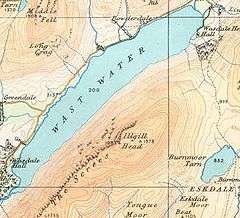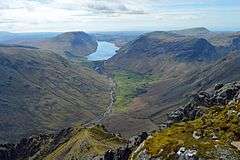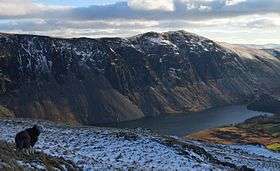Wast Water
| Wast Water | |
|---|---|
 Looking towards Wasdale Head | |
 Map of 1925 | |
| Location | England |
| Coordinates | 54°26′30″N 3°17′30″W / 54.44167°N 3.29167°WCoordinates: 54°26′30″N 3°17′30″W / 54.44167°N 3.29167°W |
| Type | Ribbon Lake |
| Primary inflows | see list |
| Primary outflows | River Irt |
| Basin countries | United Kingdom |
| Max. length | 3.03 miles (4.88 km) |
| Max. width | 0.49 miles (788.58 m) |
| Surface area | 1.08 miles2 |
| Max. depth | 258 feet (79 m) |
| Shore length1 | 6.84 miles |
| Surface elevation | 200 feet (61 m) |
| 1 Shore length is not a well-defined measure. | |
Wast Water or Wastwater (/ˈwɒst.wɔːtər/ WOST-waw-tər) is a lake located in Wasdale, a valley in the western part of the Lake District National Park, England. The lake is almost 3 miles (4.8 km) long and more than one-third mile (540 m) wide. It is the deepest lake in England[1] at 258 feet (79 m), and is owned by the National Trust. It is one of the finest examples of a glacially 'over-deepened' valley. The surface of the lake is about 200 feet above sea level, while its bottom is over 50 feet below sea level.
Surroundings
The head of the Wasdale Valley is surrounded by some of the highest mountains in England, including Scafell Pike, Great Gable and Lingmell. The steep slopes on the southeastern side of the lake, leading up to the summits of Whin Rigg and Illgill Head, are known as the "Wastwater Screes" or on some maps as "The Screes". These screes formed as a result of ice and weathering erosion on the rocks of the Borrowdale Volcanic Group, that form the fells to the east of the lake, towards Eskdale. They are approximately 2,000 feet, from top to base, the base being about 200 feet below the surface of the lake.
A path runs the length of the lake, through the boulders and scree fall at the base of this craggy fell-side. On the northwestern side are the cliffs of Buckbarrow (a part of Seatallan) and the upturned-boat shape of Yewbarrow. Wast Water is the source of the River Irt which flows into the Irish Sea near Ravenglass.
Name origin and pronunciation
"Wastwater" comes from "Wasdale" plus English "water". " 'Wasdale lake' or 'the lake of Vatnsá, lake river'. The present name rather curiously contains the reflexes of both Old Norse 'vatn' 'water', 'lake', and Old English 'wæter' 'water', with the meaning 'lake' probably influenced by the Old Norse 'vatn'.[2]
The valley is pronounced as in was, not with a hard a: the name of the lake similarly but with a soft "s" as in "thou wast". The lake is named "Wast Water" on Ordnance Survey maps but the spelling "Wastwater" is used with roughly equal frequency, including by its owner, the National Trust, along with the Cumbria Tourist Board, and the Lake District National Park Authority.
Points of interest
The Lady in the Lake
In 1976, The Wasdale Lady in the Lake, Margaret Hogg, was murdered by her husband and her body was disposed of in the lake. She was found after eight years, with her body preserved like wax due to the lack of oxygen in the water.
Underwater gnomes
In February 2005 it was reported that a "gnome garden" complete with picket fence had been placed in the lake as a point of interest for divers to explore. It was removed from the bottom of Wastwater after three divers died in the late 1990s.[3][4] It is thought the divers spent too much time too deep searching for the ornaments. Police divers report a rumour that the garden had been replaced at a depth beyond the lowest they were allowed to dive.
PC Kenny McMahon, a member of the North West Police Underwater Search Unit, said "Wastwater is quite clear at the bottom, but there's nothing to see. At a depth of about 48 m, divers had taken gnomes down and put a picket fence around them. But several years ago there were a number of fatalities and the Lake District National Park Authority asked us to get rid of them. We went down there, put them in bags and removed the lot. But now there's a rumour about a new garden beyond the 50 m depth limit. As police divers we can't legally dive any deeper so, if it exists, the new garden could have been purposefully put out of our reach."
Water extraction
Water was first pumped from the lake during World War II to supply the Royal Ordnance Factory at Drigg. It is pumped to the nearby Sellafield nuclear facility as an industrial water supply.[5] The Nuclear Decommissioning Authority is allowed to extract from the lake a maximum of 18,184.4 m³ a day (over 4 million gallons), or 6,637,306 m³ a year, to use on that site.
Favourite view
On 9 September 2007, Wast Water was announced as the winner of a vote to determine "Britain's Favourite View" by viewers of ITV.

Gallery
- Wasdale from the shores of Wastwater. Yewbarrow is on the left, Great Gable in the centre and the Scafell range on the right.
 The view from the cairn put up by the Westmorland Brothers to the SW of the summit of Great Gable - Wastwater in the distance.
The view from the cairn put up by the Westmorland Brothers to the SW of the summit of Great Gable - Wastwater in the distance. Illgill Head with Wastwater at its foot.
Illgill Head with Wastwater at its foot. Wastwater looking towards Wasdale Head
Wastwater looking towards Wasdale Head
Tributaries
Clockwise from River Irt
- Countess Beck
- Smithy Beck
- Goat Gill
- Nether Beck
- Over Beck
- Mosedale Beck
- Lingmell Beck
- Hollow Gill
- Straighthead Gill
In literature
In the book Goodbye, Mr. Chips, Mr Chipping meets his wife at Wasdale Head.
References
- ↑ The Lake District National Park Authority
- ↑ Whaley, Diana (2006). A dictionary of Lake District place-names. Nottingham: English Place-Name Society. pp. lx,423 p.360. ISBN 0904889726.
- ↑ "Underwater gnome threat 'returns'". BBC News. 2005-02-14. Retrieved 2008-10-17.
- ↑ Hartley, Emma (2007-03-16). "Bearded wonder". London: The Telegraph. Retrieved 2008-10-17.
- ↑ Radioactivity in Food and the Environment, 2010